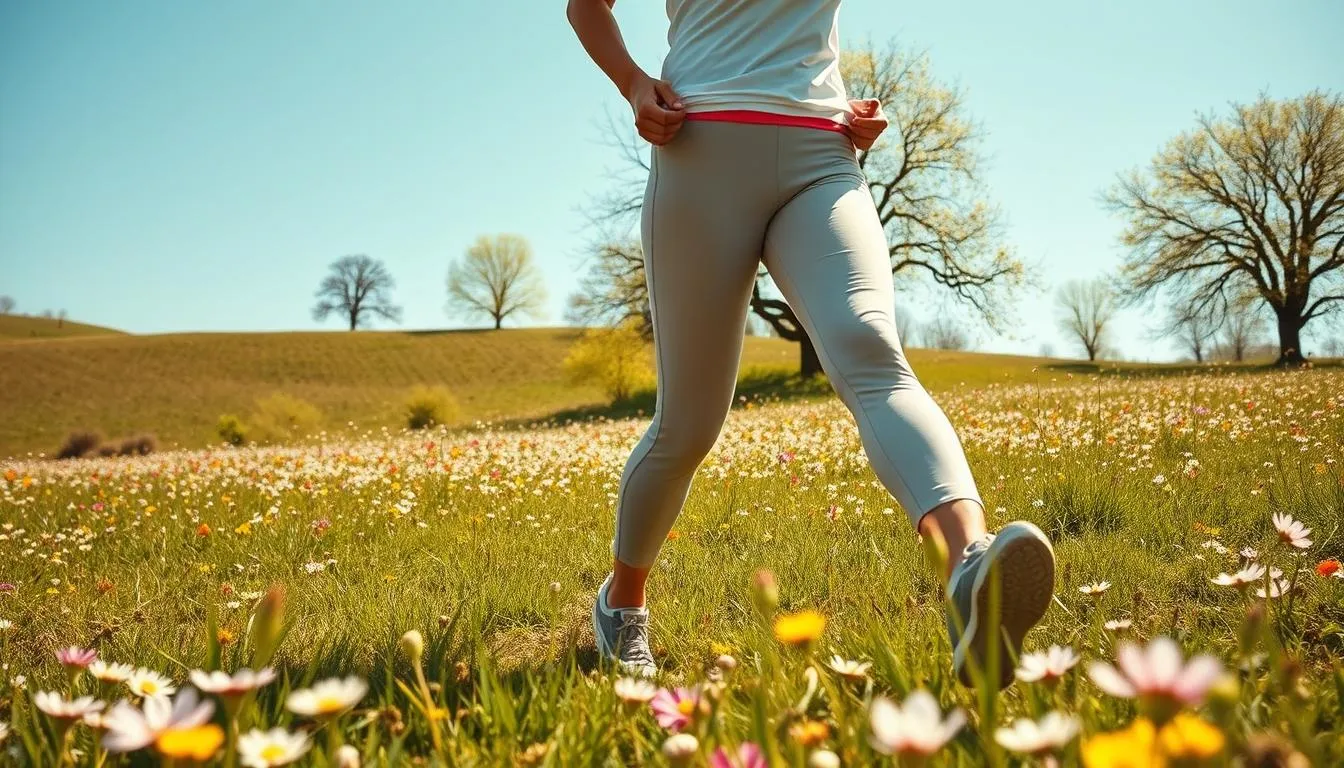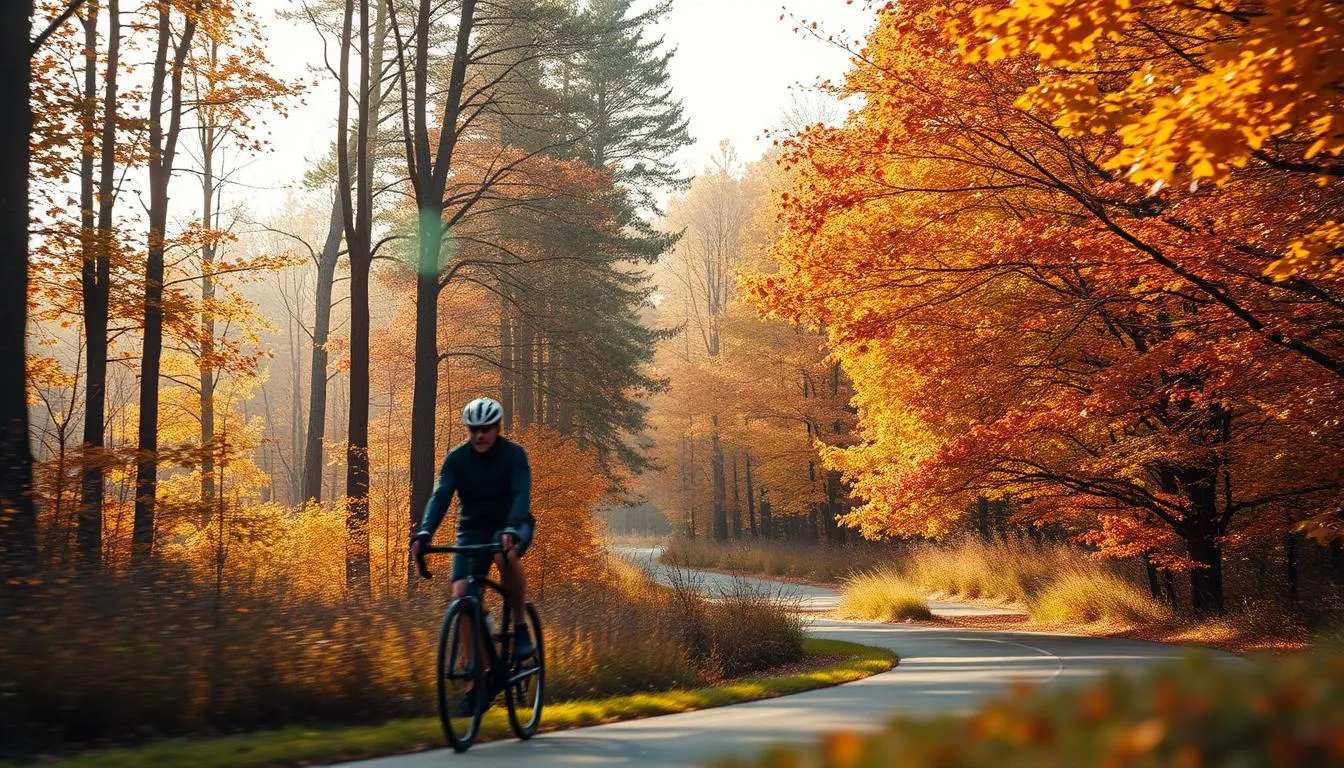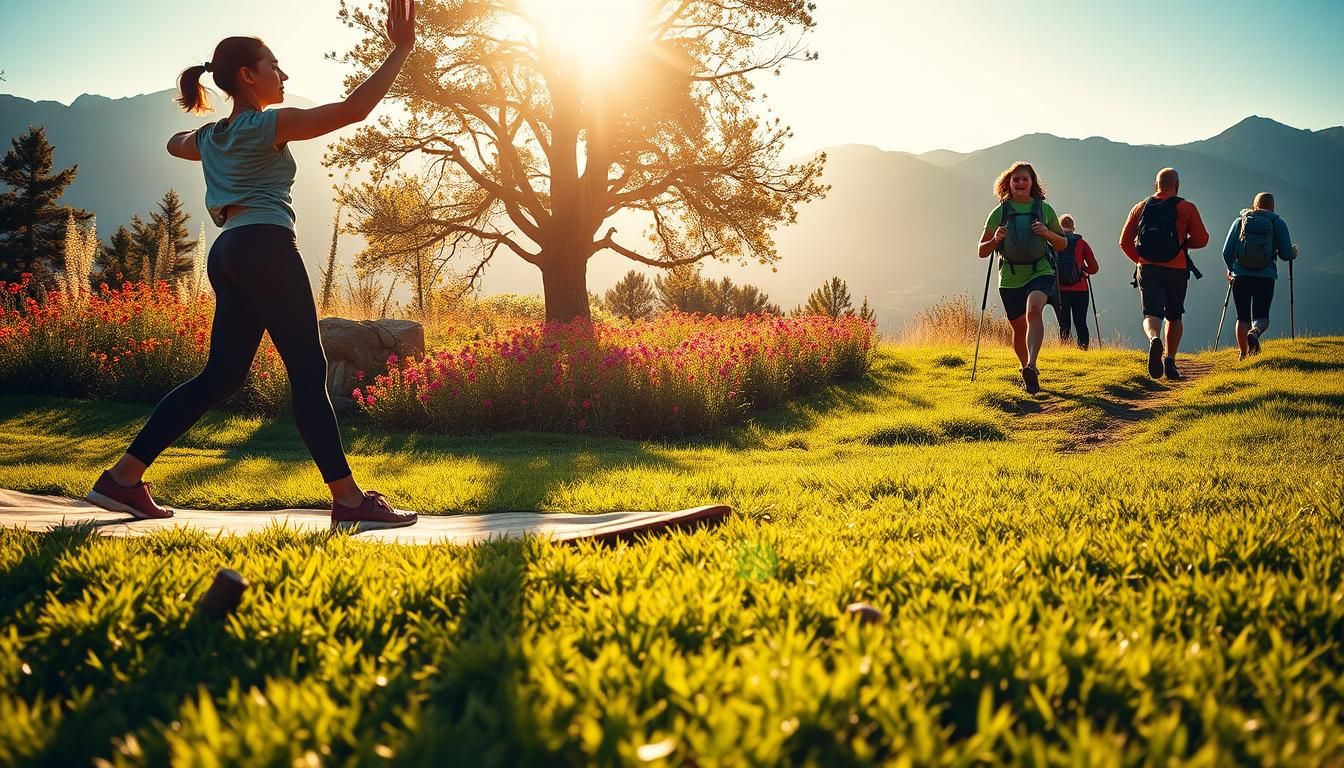Surprising fact: a 2019 study found that spending at least 120 minutes per week outdoors links to better health, and a 2023 Nature study showed short outdoor walks sharpen memory and focus more than indoor walks.
This guide helps you stay active across every season by matching options to the weather so your workout never stalls. You’ll find beginner to advanced workouts that fit any routine and equipment level, from no-equipment HIIT to bench circuits and field-line drills.
Expect quick wins: more energy, a better mood, and tangible health benefits. We cover spring base building, summer water sessions, fall endurance, and winter snow-sport options, and consider exploring sport-specific performance technology for additional techniques.
Smart structure matters: always start with a warm-up and finish with a cooldown. Stack moves that target the whole body using parks, stairs, fields, and trails. Use hill repeats, jump rope, and bench drills to scale intensity safely and keep variety in your fitness plan.
Key Takeaways
- Spend at least 120 minutes a week outside to boost health and mood.
- One plan fits all levels: bodyweight to kettlebell workouts work well.
- Include warm-ups and cooldowns to protect joints and improve recovery.
- Use parks, stairs, and trails for whole-body and cardio strength.
- Mix hiking, cycling, swimming, and field sprints to keep variety.
Why Train Outside Right Now: Benefits, Fresh Air, and Year-Round Motivation
Choosing to move outside turns short pockets of time into big wins for both body and mind. A 2023 Nature study found short walks outside sharpen memory and focus more than indoor walks. A 2019 analysis linked 120+ minutes a week outdoors with better self-reported health and well-being.
Fresh air and sun lift mood and boost motivation. A 2013 review in Extreme Physiology & Medicine showed natural settings reduce stress, restore mental energy, and improve self-esteem.
Compared with the gym, the open setting offers more space, fewer crowds, and simple, gear-light options like HIIT, stair repeats, or bench circuits. Varying weather and terrain engages stabilizers and core, and it keeps sessions mentally stimulating.
“Nature can reduce stress and restore attention, making movement more effective for both focus and mood.”
Quick programming: warm up with light jogging, arm circles, and leg swings; cool down with easy walking and light stretches. Save time by choosing a nearby park or route to cut commute and build consistency.
| Benefit | Evidence | Quick tip |
|---|---|---|
| Sharper focus | 2023 Nature study | Try a 20‑minute walk before work |
| Better well‑being | 2019 120+ min weekly | Split sessions across the week |
| Reduced stress | 2013 review | Use brief fresh air breaks in circuits |
Ready to start? Pick a local route, set a 20–30 minute window, and get outside today to build momentum. For more practical routines and variations, see this guide to outdoor exercise.
Spring Outdoor Workouts to Build a Base and Enjoy the Weather
Use spring’s moderate temperatures to focus on base-building walks, easy hikes, and a park bench circuit that strengthens the whole body.

Brisk walking and easy hiking for lower body strength and mental health
Start with brisk walking intervals to rebuild aerobic capacity. Use landmarks to set your pace and aim for 20–30 minutes as a baseline routine.
Try easy hiking once a week. Uneven trails challenge stabilizing muscle groups and build lower body endurance. A 170‑lb person can burn roughly 693 calories in 90 minutes of hiking.
Park bench circuit: incline pushups, step-ups, dips, and split squats
Rotate the following circuit: 20 incline pushups, 30s step‑ups, 30s V‑crunches, 15 triceps dips, 10 Bulgarian split squats per side, 30s incline mountain climbers, and 20s box jumps.
Progress by changing tempo, step height, or range of motion instead of adding equipment.
Beginner-friendly HIIT: light jog warm-up, bodyweight intervals, cooldown
Warm up 5–10 minutes with a light jog and mobility. Do 15–20 minutes of alternating bodyweight intervals and easy walking, then cool down with short walking and stretches.
- Weekly structure: one hike, one bench circuit, one interval day.
- Safety: wear proper shoes, bring water, and check trails after rain.
- Pacing: keep early weeks conversational; increase intensity slowly.
Summer Outdoor Workouts: Water, Sun, and Fun Without the Gym
Warm days are perfect for swapping the treadmill for water and quick, high-impact rounds. Choose activities that keep you cool, protect energy, and deliver big fitness benefits in shorter sessions.
Swimming for full-body strength, cardio, and core engagement
Swimming hits the lats, traps, chest, arms, and core while providing strong cardio work with low joint load. A 170-lb person burns about 270 calories in 30 minutes at an easy pace and ~385 at higher intensity.
Stand-up paddleboarding and kayaking for upper body and balance
SUP challenges balance and the lower body while paddling builds upper-body endurance. Kayaking emphasizes upper body and core and can burn ~385 calories per hour for a 170-lb person.
Beach-ready bodyweight HIIT and no-equipment 7-minute blasts
When time or heat limit you, try a Tabata-style 7-minute blast (20s on/10s off) with burpees, lateral hops, pushups, and quick-feet drills. Use 20–60 second breaks as needed and train early or late to avoid peak sun.
- Keep it smart: hydrate, wear sunscreen, and use the talk test to pace effort.
- Tip: alternate swim days with land circuits to mix cardio and core work without too much sweat in one session.
Fall Fitness Outside: Build Endurance and Variety as Temps Cool
As the air chills, longer sessions become comfortable and a great way to add endurance and variety. Use steady, consistent work to build stamina and keep workouts interesting as daylight shifts.

Cycling at a steady pace for cardio and lower body muscle groups
Use steady cycling to boost aerobic capacity. Casual rides work glutes, quads, hamstrings, calves and even core because balance matters on the bike. A 170‑lb person burns ~308 calories per hour at an easy pace.
Trail hiking to challenge balance, glutes, and core on uneven terrain
Switch pavement for trail hiking to recruit stabilizers in ankles and hips. Uneven ground targets calves, hamstrings, glutes and quads and can burn about 693 calories in 90 minutes for a 170‑lb person.
Recreational sports like tennis, soccer, or basketball for full-body workouts
Layer in court or field play for fast footwork and trunk rotation. Singles tennis can burn ~616 calories per hour, while casual soccer or basketball is roughly 460–540 calories.
- Practical way: mix rides, hikes, and games across the week to keep fitness fun.
- Use easy walking days for recovery and to manage times between hard efforts.
- Pick safe routes with shoulders or paths and carry a light wind layer for descents.
Winter Outdoor Training: Cold-Weather Activities That Keep You Moving
Use winter’s unique conditions to emphasize skills—controlled descents, steady climbs, and time-efficient cardio bursts. Cold weather can boost focus and support overall health when you plan wisely.
Skiing and snowboarding for cardio, strength, and balance
Downhill skiing and snowboarding pair cardio demand with leg and core strength. A 170-lb person burns about 385 calories per hour of casual downhill skiing. Focus on soft knees, hip hinge on descents, and steady breathing uphill.
Layered walks and hill intervals for efficient sessions
When gear or slopes are off the table, choose brisk, layered walks and short hill intervals to get quality minutes. Start with a dynamic warm-up indoors—leg swings and arm circles—then move outside.
- Wear layers and shoes with good traction to manage icy surfaces.
- Hydrate before and after; cold air reduces thirst but not water needs.
- If equipment access is limited, use neighborhood hills or bodyweight circuits to maintain strength and balance between ski days.
| Activity | Calories/hr (170 lb) | Key equipment | Session |
|---|---|---|---|
| Downhill skiing | ~385 kcal | Skis, boots, helmet | 45–90 minutes |
| Snowboarding | ~350–400 kcal | Board, boots, pads | 30–60 minutes |
| Hill intervals / brisk walk | ~200–400 kcal | Layered clothing, shoes | 20–40 minutes |
Cool down with light walking and stretching to reduce stiffness. Treat winter as a season to refine technique and build strength for spring progress.
Seasonal outdoor training ideas
A few targeted rounds of jumps, sprints, and bodyweight moves turn any green space into a high-value workout zone.
Quick-hit HIIT: jump rope, sprints, agility
Jump rope intervals are perfect between sets—try 50 skips to raise heart rate, then move straight into 20–40 seconds of sprints or stair hops.
Work in short bursts: use 20/10, 30/30, or 40/20 formats and take a brief break to reset pace and breathing.
Park lap circuits with strength moves
Run a lap, then do a strength move at a station. Lunges, bench dips, or incline mountain climbers keep the session balanced for both cardio and core.
Track progress by counting completed rounds in a set time and repeat the format weekly to measure gains.
Hill runs and field-line drills for speed and power
Use short hill sprints or field lines for side shuffles, bear crawls, walking planks, and toe taps on a bench. These build leg power and coordination while keeping total times low.
“Keep form first under fatigue—brace the core and land softly to protect joints.”
- Go-to HIIT template: 50 skips → 10 pushups → 15 air squats → 30s plank; repeat 4–6 times.
- Use stairs or hills for 6–10 x 10–20 second power bouts with full recovery between efforts.
- Warm up dynamically and finish with a cooldown walk to reduce soreness and aid recovery.
For a quick spring workout plan and more variations, see the spring workout guide.
Beginner-Friendly Outdoor Workouts You Can Do in 15-30 Minutes
When time is tight, a structured 15–30 minute session delivers real gains without fuss.
Start simple: five minutes of a light jog or dynamic mobility, 10–20 minutes of intervals, and a five-minute cooldown makes an easy template to follow.
Walking intervals: build time and pace safely
Alternate brisk walking with an easier recovery pace to raise heart rate without strain. Try 1 minute brisk / 2 minutes easy for ten minutes, then walk slowly to recover.
Technique: stand tall, keep shoulders relaxed, and breathe steadily. Track by time rather than distance to remove pressure and keep progress consistent.
Low-impact skating or cycling for joint-friendly cardio
Inline skating and easy bike rides are gentle on joints but burn serious calories. A 170-lb person can burn roughly 424 calories in 30 minutes of casual skating; casual cycling is about 308 calories per hour.
Wear a helmet for the bike and wrist protection for skating. Pick flat, well-lit routes and layer clothing so you can adjust through warm-up and cooldown, and consider exploring adaptive training modifications for additional techniques.
| Session Part | Duration | Goal |
|---|---|---|
| Warm-up | 5 minutes | Increase blood flow, mobility |
| Intervals | 10–20 minutes | Work capacity with short efforts |
| Cooldown | 5 minutes | Lower heart rate, stretch |
Keep expectations realistic. Two or three short sessions per week build momentum. Choose scenic routes or a friend to keep the routine enjoyable and help you stay active.
Intermediate and Advanced Outdoor Workouts with Minimal Equipment
Push your fitness further with compact, equipment-light sessions that challenge strength, power, and cardio in short blocks. These routines use one kettlebell or a pair of dumbbells and a small running area to deliver big results.

Kettlebell EMOM: Full‑body five‑minute blast
Format: Every minute on the minute (EMOM) for 5–10 minutes.
Minute 1: 8 RDL-to-thrusters. Minute 2: 8 pushups. Minute 3: 20 mountain climbers (or 30s later rounds). Repeat.
Why it works: Combines hinge, thrust, push, and core bracing for dense strength and conditioning in short times.
Dumbbell upper-body HIIT
Rotate close-grip chest presses with crunches, renegade rows, weighted walkouts to rows with knee raise and twist, and over-the-shoulder chops.
Tip: Use 30–45 second intervals with 15 seconds rest. Keep the core engaged and move deliberately to challenge anti-rotation and shoulder stability.
Shuttle run + shoot-through finisher
Set two cones: middle and far. Alternate shuttle runs to each cone, then perform 5 shoot-throughs (plyo or low crawl). Add one shuttle run each round for 5 minutes.
Result: A compact cardio push that spikes heart rate and forces recovery practice between efforts.
“Focus on quality reps and steady nasal breathing between rounds to manage effort and speed recovery.”
- Program a kettlebell EMOM to build strength and conditioning with minimal equipment.
- Use dumbbells for upper-body HIIT that taxes the core and grip while keeping sessions short.
- Finish with a 5‑minute shuttle + shoot-through to maximize cardio and sweat.
- Progress by increasing reps, shortening rest, or extending rounds while holding form.
- Track times and rep goals to measure progress and avoid junk volume.
| Workout | Gear | Duration | Goal |
|---|---|---|---|
| Kettlebell EMOM | 1 kettlebell | 5–10 min | Strength + conditioning |
| Dumbbell HIIT | Pair of dumbbells | 10–15 min | Upper-body power & core |
| Shuttle finisher | 2 cones or markers | 5 min | Cardio spike |
Combine these blocks with weekly runs, rides, or hikes to maintain balance and avoid plateaus. A compact setup can mimic a home gym session and deliver real performance gains.
Make Nature Your Gym: Park Bench, Stairs, Fields, and Trails
Use the park around you as a compact gym where benches, steps, and open turf become simple, effective stations. A quick plan links full‑body bench flows with stair sprints, walking laps, and short trail segments to hit strength, core, and leg power.
Full‑body bench flow
Chain V‑crunches, incline mountain climbers, box jumps, dips, incline pushups, step‑ups, and split squats into a circuit. Do 30–60 seconds per move or 8–12 reps, then rotate 3–4 rounds for a compact session.
Why it works: The bench creates pressing, stepping, and core leverage so your body supplies load while you keep equipment minimal.
Stair runs and hill repeats
Use stairs or a short hill for 6–10 x 10–20 second sprints with full recovery. Focus on strong drive, quick turnover, and controlled descents to protect joints.
Session tips: blend walking laps between sets to manage fatigue, wear supportive shoes with good traction, and finish with light walking or a gentle hike to cool down. Cyclists can end a ride at a park and add a brief bench circuit to hit upper body and core.
Safety, Weather, and Gear Tips for Outdoor Workouts in the U.S.
Smart prep keeps every session safer and more productive. Spend 5–10 minutes warming up with light cardio and dynamic mobility before you start. Finish with an easy walking cooldown and gentle stretches to lower soreness and aid recovery.
Warm-ups, cooldowns, and hydration across seasons
Warm-up: jog, jumping jacks, arm circles, and leg swings wake muscles and joints.
Hydrate year-round: drink water before and after sessions and add electrolytes during long, hot efforts. Cold air can reduce thirst but not water needs.
Sun, shoes, and layers: dressing for temperature, wind, and terrain
Dress in layers for cold and choose moisture-wicking fabrics in heat. Use sunscreen and a hat for sun protection.
Shoes matter: pick tread that suits trails, stairs, or wet grass to cut slip risk and protect ankles.
Listening to your body: pacing, rest breaks, and mental health benefits
Use pacing strategies and take a short break when form fades. Shift routes to sheltered parks on windy days and reduce intensity during poor air alerts.
Carry ID, a phone, a small water bottle, and a light layer on longer outings. If you feel dizzy or unusually tired, stop and recover — your long-term health and mental health matter more than one session.
Conclusion
Wrap up your plan by picking a single, doable workout and a nearby route to help you stay active this week. Start small with one of the suggested workouts so momentum builds fast.
Choose a quick workout that fits your goals. Short sessions boost overall fitness and make regular exercise feel easy to keep.
Rotate focus by season: spring base walks, summer water days, fall rides, winter hill work. Most options need little equipment, so there are many ways to move.
Outdoor activity is a great way to use limited time and improve mood. Pick one activity, track your times, and mix modes—bike then a short bench circuit or a quick hike after work.
Keep safety simple: layer up, wear good shoes, hydrate, and pace yourself. Choose a nearby trail or park and put your next session on the calendar today.
FAQ
What are the main benefits of exercising outside year-round?
Training outdoors improves cardiovascular fitness, boosts mood through fresh air and sunlight, and adds variety to routines. It engages more stabilizer muscles on uneven ground, supports mental health, and can reduce gym costs. Aim for activities that match your goals—walking or hiking for endurance, strength circuits on a park bench for muscle work, or swimming for low-impact full-body training.
How do I pick the right workout for each season?
Choose activities that fit the weather and your comfort. In spring, build a base with brisk walks, easy hikes, and light HIIT. Summer favors swimming, paddleboarding, and short no-equipment blasts to avoid heat strain. Fall is perfect for cycling, trail hikes, and team sports. In winter, opt for skiing, snowshoeing, or layered hill walks. Always consider daylight, temperature, and footing.
How long should a beginner outdoor workout be?
Start with 15–30 minutes if you’re new. Try walking intervals, a short park-bench circuit, or a low-impact bike ride. Gradually increase duration or intensity by 5–10 minutes each week. Consistency matters more than duration—three short sessions per week beat sporadic long workouts.
What gear do I really need to exercise safely outside?
Essentials include supportive shoes suited to the activity, weather-appropriate layers, a hat and sunscreen for sun protection, and a reusable water bottle. For added options, carry a jump rope, a set of light dumbbells or kettlebell, and a small first-aid kit. In winter, traction devices for shoes help on ice and snow.
Can I build strength without a gym while outdoors?
Yes. Use bodyweight moves (pushups, lunges, split squats, planks), park benches for step-ups and dips, and natural features for pull-ups or incline work. Portable tools like kettlebells and dumbbells allow EMOMs and HIIT sessions that target multiple muscle groups, including lower body and core.
How do I avoid overheating in summer workouts?
Schedule sessions for early morning or late evening when temperatures and sun exposure are lower. Wear breathable fabrics, stay hydrated, reduce intensity, and shorten bouts—7–20 minute high-effort segments work well. Seek water-based options like swimming or paddleboarding to cool off while exercising.
What are quick effective outdoor HIIT options?
Try a 7- to 20-minute circuit of jump rope, sprints, agility drills, stair climbs, and bodyweight moves like burpees and squat jumps. Alternate work and rest (e.g., 30 seconds on, 30 seconds off) or use EMOM formats to control pacing. These deliver strong cardio and metabolic benefits in little time.
How can I keep workouts varied and fun so I stick with them?
Rotate activities by week or season—swap cycling for trail runs, add recreational sports like tennis or soccer, or use water sports in summer. Mix strength days with cardio and mobility work. Invite a friend, join a local group class, or set short challenges to keep motivation high.
Are there safety tips for exercising outdoors in winter?
Layer up with moisture-wicking base layers and windproof outer shells. Warm up indoors if possible, wear gloves and a hat, and use traction aids for icy surfaces. Shorten sessions when temperatures drop, stay visible in low light, and hydrate—cold weather still causes fluid loss.
How do I structure a park-bench circuit for full-body training?
Combine incline pushups, step-ups, dips, split squats, and V-crunches. Perform each move for 30–45 seconds with 15–30 seconds rest and repeat for 3–5 rounds. Adjust reps or time to match fitness level. This targets chest, legs, shoulders, and core with no gym required.
What precautions should I take in hot, sunny conditions?
Wear sunscreen, sunglasses, and a breathable hat. Hydrate before, during, and after workouts. Lower intensity or shorten duration during peak heat, and choose shaded routes or water-based activities when possible. Keep an eye out for signs of heat exhaustion: dizziness, nausea, or excessive fatigue.
How can I train for speed and power outdoors with minimal equipment?
Use hill sprints, shuttle runs, field line drills, and plyometrics like box jumps or lunge jumps. Add kettlebell swings and RDL-to-thruster combos for explosive strength. Structure sessions as short, intense intervals with full recovery to maximize power gains.
What are good low-impact options for joint-friendly cardio?
Cycling, swimming, walking, and low-impact skating are ideal. They reduce joint stress while improving cardio fitness. Alternate these with strength and mobility work to protect knees and hips while building endurance.
How do I balance training intensity with recovery when exercising outdoors?
Follow a week-to-week plan that mixes hard days, moderate sessions, and active recovery like easy walks or mobility work. Listen to your body—take extra rest if you feel persistent soreness or fatigue. Proper sleep, nutrition, and hydration speed recovery and reduce injury risk.
Can outdoor workouts improve mental health as well as physical fitness?
Yes. Time in nature lowers stress, improves mood, and enhances focus. Combining movement with fresh air and sunlight supports better sleep and resilience. Simple routines like walking or trail hikes offer meaningful mental health benefits alongside physical gains.
